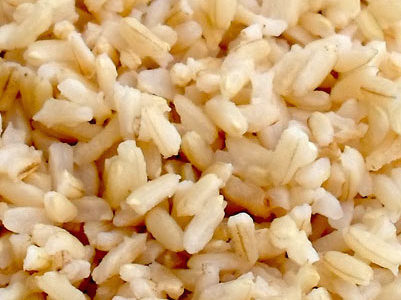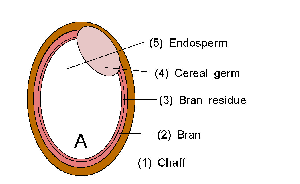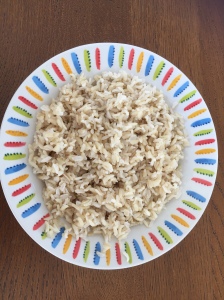My new book The Guerrilla Diet And Lifestyle Program –
Wage War on Weight & Poor Health And Learn To Thrive In The Modern Jungle is now available HERE on Amazon!
How to make brown rice taste like white rice and get your kids to love it and why this is important to do.
White rice was once brown rice, but the cereal germ, bran residue and the bran around the kernel were removed from it to make it white. The germ and the bran have many benefits that help prevent many modern day diseases and increase the quality of our life.
In the slides above you can easily see the difference between white and brown rice. B is brown rice (rice without the chaff). D is white rice.
But why is it important to make the change from white rice to brown rice?
Here are the health benefits from consuming brown rice in comparison to white rice:
One cup of brown rice provides 80% of our daily manganese requirements. Manganese helps the body synthesize fats which are important for a healthy nervous system and reproductive system. Manganese also supports the production of energy from proteins and carbohydrates. Manganese is a critical component of the powerful antioxidant enzyme Superoxide dismutase (SOD) which protects against free radical damage produced during energy production.
Brown rice is also rich in selenium which reduces the risk for developing major illnesses such as cancer (through the inhibition of cancer cell proliferation), heart disease (through its antioxidant properties), hypothyroidism (through its involvement in thyroid hormone metabolism) and arthritis (through its involvement in immune functions).
Brown rice also cares for heart health by lowering LDL cholesterol by 7% (2)
Another study published in the American Heart Journal showed that eating at least 6 servings of whole grains each week slowed progression of atherosclerosis, the deposition of plaque on the inner lining of blood vessels causing them to narrow. (3)
Brown rice is rich in phytonutrients which support a friendly microbiota in our gut protecting us from many modern day diseases including heart disease and breast and other hormone-dependent cancers.
Brown rice is also rich in insoluble fiber,which protects against the formation of gallstones. (4)
Brown rice is also great for weight control contrary to white, processed rice. Brown rice has been shown to not only to help control weight, but also to help in maintaining a healthy weight. (1)
Brown rice is also rich in magnesium, a mineral that acts as a co-factor for more than 300 enzymes, including enzymes involved in the body’s use of glucose and insulin secretion and therefore reduces risk of suffering from type II diabetes. (5)
A research study showed that suffering from type II diabetes was 31% lower in black women who frequently ate whole grains compared to those eating the least of these magnesium-rich foods. (5)
Magnesium helps regulate nerve and muscle tone by balancing influx of calcium into cells thus keeping our nerves (and blood vessels and muscles) more relaxed. If our diet is deficient in magnesium, calcium enters the cells more easily making cells over active. This contributes to high blood pressure, muscle spasms, spasms of the airways occurring in asthma, migraine headaches, stress and tiredness.
The importance for brown rice for children:
Naturally magnesium rich brown rice improves children’s sleep, mood, and prevents constipation. But more importantly, high magnesium levels protect against ADHD and hyperactivity.
Naturally selenium rich brown rice helps children easily fight illness and infection and protect them from asthma.
Exchanging brown rice for white rice in your and your family’s diet can work wonders for your health. So how can we make this transition easy?
The answer is really very simple and it lies in the secret of soaking the rice before cooking.
Take a cup of brown Basmati rice. Throughly rinse it and cover it with water to soak for 2 hours.
After soaking, drain the water. Place rice in a pot and cover with three cups of water (for every one cup of rice). Cover and bring to boil for 5 minutes. Reduce heat to a simmer until all the water is absorbed. Remove from heat, still covered and allow to stand for 15 minutes.
This will produce soft brown rice similar in texture and appearance to white rice.
Enjoy!
To make any vegan soup have rich flavour, see my recipe for the perfect vegan soup stock HERE
Thank you for taking the time to read this. If you are serious about improving your health no matter what your age or circumstance are, and are ready to achieve better results with your weight loss attempts, guaranteed, then join my mailing list where you will receive my weekly newsletter with groundbreaking health, motivational content, recipes, supplement recommendations, easy workout, as well as many FREE bonuses and special offers. Click HERE to subscribe. Or visit the Guerrilla Diet Website for my health advice, offers, courses and free information HERE.
References:
- Liu S, Willett WC, Manson JE, Hu FB, Rosner B, Colditz G. Relation between changes in intakes of dietary fiber and grain products and changes in weight and development of obesity among middle-aged women. Am J Clin Nutr. 2003;78(5):920-7. 2003. PMID:14594777.
- Anderson JW, Hanna TJ, Peng X, Kryscio RJ. Whole grain foods and heart disease risk. J Am Coll Nutr 2000;19:291S-9S. 2000. PMID:17670.
- Erkkila AT, Herrington DM, Mozaffarian D, Lichtenstein AH. Cereal fiber and whole-grain intake are associated with reduced progression of coronary-artery atherosclerosis in postmenopausal women with coronary artery disease. Am Heart J. 2005;150(1):94-101. 2005. PMID:16084154.
- Tsai CJ, Leitzmann MF, Willett WC, Giovannucci EL. Long-term intake of dietary fiber and decreased risk of cholecystectomy in women. Am J Gastroenterol. 2004;99(7):1364-70. 2004. PMID:15233680.
- Van Dam RM, Hu FB, Rosenberg L, Krishnan S, Palmer JR. Dietary calcium and magnesium, major food sources, and risk of type 2 diabetes in U.S. Black women. Diabetes Care. 2006;29(10):2238-43. 2006. PMID:17003299.








Leave A Response